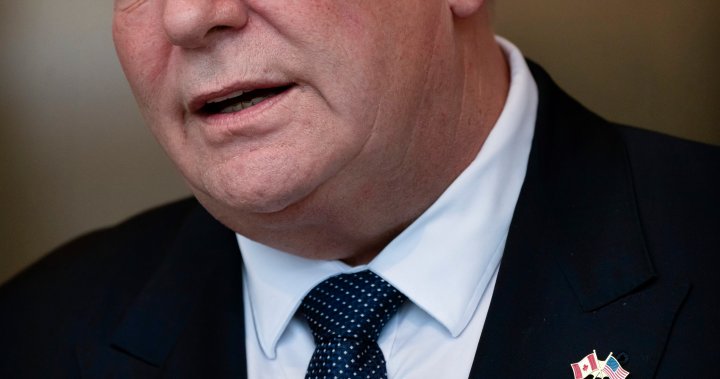Ontario budgeted $52M for commercials meant to fend off U.S. tariffs

It was a charm offensive aimed at American politicians and decision-makers for months.
Lawmakers landing at Washington Dulles International Airport were met with signs reminding them that Ontario is “an economic partner that helps employ millions of American workers.”
Politicians who thumbed through the pages of The Washington Post were told that Ontario is a “secure economic partner in an insecure world.” The message was even blasted out to the Super Bowl’s millions of viewers.
As Donald Trump was inaugurated and started his term as president, Ontario’s message of partnership was everywhere.
But achieving a level of saturation didn’t come cheap.
New invoices and documents, obtained by Global News using freedom of information laws, show the budget for the advertising blitz was set by Ontario Premier Doug Ford’s office at $52 million.
Between mid-December and mid-February, the provincial government shelled out roughly $38 million of that money to buy advertising space. The vast majority went to television commercials, particularly on Fox News.
When he unveiled the new strategy in November 2024, Minister of Economic Development, Job Creation and Trade Vic Fedeli said it aimed to underscore the United States’ close relationship with Ontario.
Fedeli wanted to push the narrative as Trump threatened massive tariffs and mused about Canada becoming the 51st state.
“It’s really important just to remind them subtly: we’re a trusted partner to your north, we’ve always been there for you and we’ll be there for you tomorrow,” he said.
By March, however, the United States had included Canada on its list of countries facing tariffs on steel, aluminum and autos. David Paterson, Ontario’s representative on Capitol Hill, conceded the high-value charm offensive had “been over for quite a while.”
Now, opponents of the Ford government are asking what exactly the province achieved by spending tens of millions of dollars beaming its message to American lawmakers who may not have been listening.
“The government should have been looking at: Was this changing minds? Was this influencing Donald Trump? It doesn’t appear to have done a whole lot,” Ontario NDP Leader Marit Stiles said.
The province said the campaign made 1.9 billion impressions and reached more than 100 million people in the United States.
Commercials run after U.S. President Donald Trump elected
When Trump won the United States election on Nov. 5, 2024, Ford and his team kicked into high gear, fearing his threats of tariffs and annexation could have a crushing effect on the economy.

Get breaking National news
For news impacting Canada and around the world, sign up for breaking news alerts delivered directly to you when they happen.
By noon on Nov. 6, the premier’s office had asked to increase the planned budget for a “U.S. Partnerships campaign” from $20 million to $52 million, according to emails and other documents seen by Global News.
The plan was to run advertisements targeting the United States from January to March 2025. The strategy was then revamped and reworked to start earlier.
A massive commercial buy targeting Trump’s favoured television network, Fox News, was approved to begin in December on shows with estimated audiences ranging from 6.5 to 8 million people.
The government earmarked $17.6 million to buy advertising space on four Fox News prime time shows. It also grabbed slots during American football games. An extra $400,000 was spent to put up posters promoting Ontario at transit shelters in Washington, D.C. and at airports in the United States.
In total, the province spent $18 million in December, according to the documents obtained by Global News.
That spending continued in January and February, with another total of $19.8 million. The latter cost covered commercials on Amazon Prime, YouTube, Google Search and The Wall Street Journal, among others, alongside another chunk of television commercials.
The Ford government did not confirm to Global News if the entire $52 million budget for the campaign was spent.
A spokesperson for the Ministry of Economic Development, Job Creation and Trade said the campaign made an impression.
“With the threat of tariffs, as one part of a larger engagement plan, our government launched an advertising campaign to reach Americans on American networks, highlighting our longstanding partnership and value in energy, critical minerals, and other resources that many states rely on,” they said in a statement sent to Global News.
“Our campaign received over 1.9 billion impressions and reached more than 100 million Americans, including key decision-makers who can influence trade policies with Canada and who routinely raise and celebrate the advertising campaign with Ontario officials during meetings.”
Critics question what the campaign achieved
More than six months after Trump’s election and the launch of Ontario’s campaign to win American hearts and minds, some are questioning what the province got for its money and why the commercials ran for so long.
When tariffs — which remain in place — were announced in March, Ford removed American alcohol from the shelves of the LCBO, said he would cancel a contract with Elon Musk’s Starlink and briefly threatened to cut off electricity exports to the United States.
The latter threat was quickly stood down in exchange for a meeting with U.S. Commerce Secretary Howard Lutnick, but the tariffs were not removed. Critics believe none of Ford’s actions — including the pricey commercial campaign — have had any effect.
“What we see is overspending on advertising in the United States,” Ontario Liberal Leader Bonnie Crombie said.
“And for what results, we have to ask ourselves. Did he stop the tariffs? He did not. Did he protect jobs? No, jobs are leaving the province. Did he strengthen our economy and diversify our trading partners? He did neither of those things.”
Stiles said the strategy wasn’t necessarily misguided at the beginning, but could have been cut short, with the money funnelled into relief for sectors like steel and auto manufacturing, which have seen tariff-induced layoffs.
“The government seemed to just keep wanting to throw money at advertising campaigns even at a time when Ontarians are really struggling,” she said.
Ford’s opponents have complained about his government’s use of advertising in the past, pointing to recent findings by the auditor general.
In December, the auditor general found the Ford government had spent more than any other administration on advertising. The province paid a total of $103.5 million in a single year for commercials.
The auditor general concluded those advertisements were “designed to promote the governing party” rather than to share an important message with the public.


Spirits maker Diageo will cease operations at its bottling facility in Amherstburg, Ont., early next year, as it shifts some bottling volume to the U.S., the company announced on Thursday.
The facility, which bottles Crown Royal products, will close in February in a move aimed at improving its North American supply chain.

Get breaking National news
For news impacting Canada and around the world, sign up for breaking news alerts delivered directly to you when they happen.
About 200 jobs will be affected.
“This was a difficult decision, but one that is crucial to improving the efficiency and resiliency of our supply chain network,” Marsha McIntosh, Diageo’s president of North America supply, said in a statement.
Diageo said it will engage with the community and find ways to support its employees through the transition, and work alongside Unifor to assist unionized workers.
The company said it will still maintain a “significant” footprint in Canada — including its headquarters and warehouse operations in the Greater Toronto Area, and bottling and distillation facilities in Manitoba and Quebec.
McIntosh added the company’s Crown Royal products will continue to be mashed, distilled and aged at its Canadian facilities.
© 2025 The Canadian Press

Toronto police say a 33-year-old man has been charged with attempted murder after allegedly striking two men with his car Wednesday evening.
Officers say they responded to reports of a collision in the area of Don Mills Road and Gateway Boulevard in the city’s North York neighbourhood just before 10:30 p.m.

Get daily National news
Get the day’s top news, political, economic, and current affairs headlines, delivered to your inbox once a day.
Police say two men got into an argument, leading to one man getting into his car and hitting the other man with it.
They say the man then put his car into reverse, striking a second man.
A man in his 50s was transported to hospital with serious injuries and the second man, in his 20s, had minor injuries.
Police say the suspect from Markham, Ont., faces several other charges as well, including two counts of assault with a weapon, uttering threats and dangerous driving.
© 2025 The Canadian Press

A court document shows a Lindsay, Ont., man facing charges for allegedly breaking into an apartment was carrying a crossbow when he was confronted by a tenant.
The resident, Jeremy David McDonald, is also facing assault charges in the incident on Aug. 18 — a fact that has generated widespread interest in the case.
Police information filed in court alleges that Michael Kyle Breen damaged a window and screen at McDonald’s home and carried a crossbow.
The court document says the 41-year-old Breen is charged with break and enter, possession of a weapon for a dangerous purpose, mischief under $5,000 and failing to comply with a probation order.

Get daily National news
Get the day’s top news, political, economic, and current affairs headlines, delivered to your inbox once a day.
Police have said that Breen, who is scheduled to appear in court for a bail hearing next week, was already wanted for unrelated offences.
McDonald, the 44-year-old resident, was charged with aggravated assault and assault with a weapon after he allegedly “did endanger the life” of Breen.
Premier Doug Ford blasted the decision to charge the apartment resident, saying last week that it shows “something is broken.”
Kawartha Lakes Police Chief Kirk Robertson wrote in a statement Wednesday that he recognizes the incident has generated significant public interest and “emotional” responses, but called some of the reaction “unjust and inaccurate.”
Robertson wrote that individuals have the right to defend themselves and their property, but the law requires that any defensive action be proportionate to the threat faced.
“This means that while homeowners do have the right to protect themselves and their property, the use of force must be reasonable given the circumstances,” he wrote.
© 2025 The Canadian Press
-

 Uncategorized3 months ago
Uncategorized3 months agoShop Proud, Eat Proud, Be Proud — Ottawa Canada Day Market This June 28th
-

 3 months ago
3 months agoCanada’s world junior trial saw juries tossed, intense testimony. Here’s a recap
-

 2 months ago
2 months agoRing of Fire road to bring prosperity to First Nation, problems for caribou: report
-

 2 months ago
2 months agoMeasles circulating in northeastern B.C. community, health officials warn
-

 3 months ago
3 months agoAnishinabek Nation chief says he briefed Ontario police on protests against Bill 5
-

 2 months ago
2 months agoFormer major leaguer, Jays doctor Ron Taylor dies
-

 2 months ago
2 months agoJagmeet Singh apologizes for attending Kendrick Lamar concert after Drake calls him out
-

 2 months ago
2 months agoDreaming of a lakeside cottage but can’t afford it? Co-ownership could open that door





